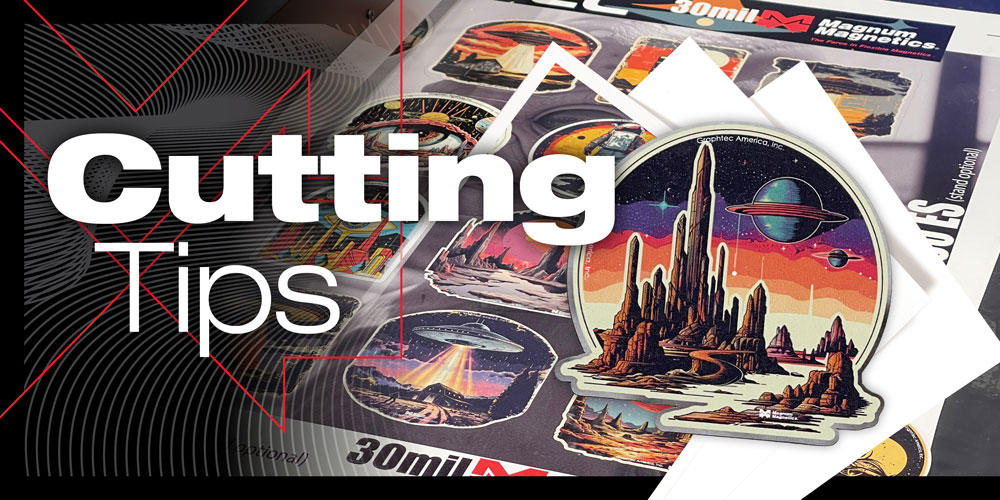
How to Cut Magnetic Sheeting: Tips for Clean, Accurate Results
Cutting magnetic sheeting might seem straightforward, but getting smooth, professional results requires the right tools, techniques, and settings. Whether you’re producing magnetic signage, promotional materials, or custom shapes, following best practices for cutting can make all the difference between a clean finish and a wasted sheet.
At Magnum Magnetics, we’ve worked with countless printers, converters, and sign shops that cut magnetic materials daily, and we’ve gathered our best recommendations to help you get it right the first time.



1. Mask the Metal Surfaces
Most digital cutters and plotters have metal on the feeder or on the exit area, just like printers. Because magnetic sheeting naturally attracts to metal, it’s essential to mask off these areas before feeding your sheet. This prevents the magnet from sticking to the cutter’s metal parts, which can cause misalignment or damage to your equipment.
Use masking tape or a non-metallic barrier wherever the sheet makes contact with metal. Treat your cutter just like your printer, if it’s magnetic, mask it off.
2. Use the Right Blade
Standard cutter blades are typically 45°, but for magnetic sheeting, a 60° blade is a much better choice. The steeper angle helps slice through thicker material more effectively, reducing drag and preventing tearing or rough edges.
We also recommend using medium pressure at first. If you notice the cut beginning to struggle, increase the pressure slightly, but only by one setting or degree at a time. Over-tightening can wear out the blade faster or risk damaging the material.
When cutting becomes difficult even after slight adjustments, it’s a clear sign that it’s time to replace your blade. A dull blade is one of the most common causes of uneven cuts or incomplete scoring.
3. Adjust Your Speed
Cutting too fast is a sure way to sacrifice accuracy. Start by setting your cutter’s speed to 20 cm per second or less—20 cm/s is generally a great starting point for magnetic sheeting.
Slowing down allows the blade to stay steady and consistent, ensuring precise edges and cleaner shapes. When speed increases, the cutter’s accuracy can decline quickly, leading to jagged or incomplete cuts. Remember: a few extra seconds per cut can save you a lot of wasted material.
4. Print and Cut in Rows
If you’re printing and cutting magnetic media, it’s best to print a row, then cut a row. Avoid printing an entire 8-foot section and then backing up to cut it later. Large sections can shift, misalign, or curl during cutting, especially on magnetic materials. By working in shorter, manageable rows, you maintain registration accuracy and minimize waste.
5. Try Scoring or Kiss-cutting Instead of Cutting Through
Many cutters don’t have enough force to cut completely through magnetic sheeting, and that’s okay. Instead of forcing a deep cut, try scoring or kiss-cutting the magnet. A score typically cuts about 80% of the way through the material, leaving just enough thickness to “snap” the magnet cleanly out of the sheet.
For best results, cut with the magnet side down. This allows you to snap the sheet cleanly if it’s not cut all the way through. If you cut with the vinyl side down and only score it, you won’t be able to snap it evenly without damaging the vinyl surface.
6. Know Your Cutter’s Limitations
Not all cutters are built to handle thicker or double-sided magnetic materials. Most standard cutters will not cut through a double-sided magnet. For those applications, you’ll need a high-end system, such as a Zünd, Kongsberg, or Cutworx cutter, that’s capable of handling thicker substrates.
If you’re using a Graphtec cutter, good news: Graphtec models are known to perform well with magnetized materials. Just make sure you follow all of the cutting tips above for the best results.
7. Consider CO2 Laser Cutting (with Caution)
Magnetic sheeting can also be cut using a CO2 laser cutting or engraving machine, but there are a few safety notes to keep in mind:
- Do not laser cut vinyl. The PVC in the vinyl gives off chlorine gases when heated, which are toxic and corrosive.
- If you must attempt laser cutting vinyl (which we do not recommend), only do so in a very well-ventilated area.
- Plain magnetic material (without vinyl) can be safely laser cut.
- Paper-laminated magnetic sheets can also be laser cut, but move quickly to prevent the paper from burning. Using a faster laser speed with two passes often produces good results.
Laser systems can produce mixed results, but always prioritize safety and ventilation when working with any coated or laminated materials.
Final Thoughts
Cutting magnetic sheeting doesn’t have to be complicated—it’s about balancing precision, pressure, and patience. By masking off metal surfaces, using a 60° blade, slowing your cutter speed, and scoring instead of forcing a full cut, you’ll get crisp, accurate edges every time.
Whether you’re producing custom magnetic signage, displays, or promotional magnets, following these best practices will help extend your blade life, protect your cutter, and ensure your magnetic media performs beautifully.
For additional tips, materials, and compatible cutting solutions, contact Magnum Magnetics—America’s leading manufacturer of flexible magnetic materials.


